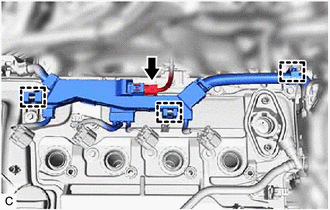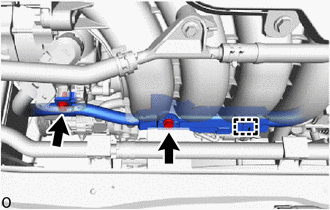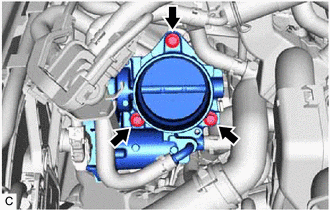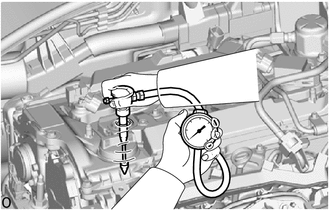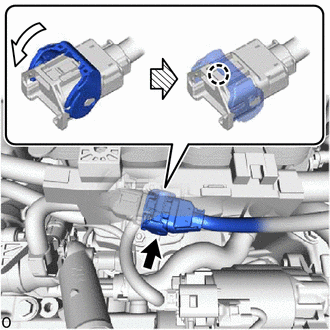-
Faulty ignition:
- Incorrect valve timing
- Fouled, shorted or improperly gapped spark plugs
- Incorrect valve clearance (valve lash adjuster assembly)
- Leaks in intake or exhaust valves
- Leaks in cylinders
- Faulty EGR
| Last Modified: 07-31-2024 | 6.11:8.1.0 | Doc ID: RM1000000028COO |
| Model Year Start: 2023 | Model: Corolla Hatchback | Prod Date Range: [11/2022 - ] |
| Title: M20A-FKS (ENGINE MECHANICAL): ENGINE: ON-VEHICLE INSPECTION; 2023 - 2025 MY Corolla Corolla Hatchback [11/2022 - ] | ||
ON-VEHICLE INSPECTION
CAUTION / NOTICE / HINT
CAUTION:
To prevent injury due to contact with an operating V-ribbed belt or cooling fan, keep your hands and clothing away from the V-ribbed belt and cooling fans when working in the engine compartment with the engine running or the engine switch on (IG).
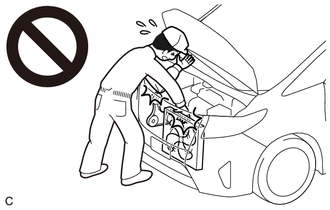
PROCEDURE
1. INSPECT ENGINE COOLANT
2. INSPECT ENGINE OIL
3. INSPECT BATTERY CONDITION
4. INSPECT SPARK PLUG
5. INSPECT AIR CLEANER FILTER ELEMENT SUB-ASSEMBLY
6. INSPECT V-RIBBED BELT
7. INSPECT V-RIBBED BELT TENSIONER ASSEMBLY
(a) Remove the V-ribbed belt.
(b) Turn the V-ribbed belt tensioner assembly clockwise and counterclockwise and check that it turns smoothly and does not catch.
HINT:
If the V-ribbed belt tensioner assembly does not turn smoothly or catches, replace the V-ribbed belt tensioner assembly.
(c) Install the V-ribbed belt.
8. INSPECT VALVE LASH ADJUSTER ASSEMBLY NOISE
(a) Rev up the engine several times. Check that the engine does not emit unusual noises.
(b) If tappet noise is heard, perform the following procedure.
(1) Idle the engine for at least 10 minutes and then stop the engine.
(2) Remove the fuel pump assembly (for High Pressure).
(3) Remove the ignition coil assembly.
(4) Remove the camshaft position sensor (for Intake Side).
(5) Remove the camshaft position sensor (for Exhaust Side).
|
(6) Disconnect the air fuel ratio sensor connector. |
|
(7) Disengage the 3 clamps.
(8) Remove the cylinder head cover sub-assembly.
(9) Push the pivot of the No. 1 valve rocker arm sub-assembly.
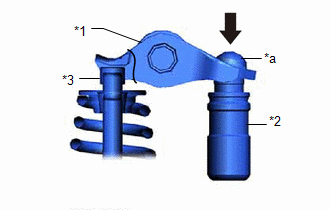
|
*1 |
No. 1 Valve Rocker Arm Sub-assembly |
|
*2 |
Valve Lash Adjuster Assembly |
|
*3 |
Valve Stem Cap |
|
*a |
Pivot |

|
Push |
OK:
The plunger is very difficult to move.
HINT:
If the plunger is easy to move, replace the valve lash adjuster assembly.
(10) Install the cylinder head cover sub-assembly.
(11) Engage the 3 clamps.
(12) Connect the air fuel ratio sensor connector.
(13) Connect the camshaft position sensor (for Exhaust Side) connector.
(14) Connect the camshaft position sensor (for Intake Side) connector.
(15) Install the ignition coil assembly.
(16) Install the fuel pump assembly (for High Pressure).
9. INSPECT IGNITION TIMING
NOTICE:
- Check the ignition timing with the cooling fan off.
- Turn off all electrical systems and the A/C.
- When checking the ignition timing, the transaxle should be in neutral or park.
(a) Warm up and stop the engine.
(b) Connect the Techstream to the DLC3.
(c) Start the engine and run it at idle.
(d) Turn the Techstream on.
(e) Enter the following menus: Powertrain / Engine / Data List / Ignition Timing Cylinder #1.
Powertrain > Engine > Data List
|
Tester Display |
|---|
|
Ignition Timing Cylinder #1 |
Standard Ignition Timing:
-3 to 3° BTDC at idle
(f) Enter the following menus: Powertrain / Engine / Active Test / Activate the TC Terminal / ON.
Powertrain > Engine > Active Test
|
Active Test Display |
|---|
|
Activate the TC Terminal |
|
Data List Display |
|---|
|
Ignition Timing Cylinder #1 |
(g) Monitor Ignition Timing Cylinder #1 of the Data List.
Standard Ignition Timing:
8 to 12° BTDC at idle
(h) Enter the following menus: Powertrain / Engine / Active Test / Activate the TC Terminal / OFF.
(i) Check that the ignition timing advances immediately when the engine speed is increased.
10. INSPECT ENGINE IDLE SPEED
NOTICE:
- Check the engine idle speed with the cooling fan off.
- Turn off all electrical systems and the A/C.
- When checking the engine idle speed, the transaxle should be in neutral or park.
(a) Warm up and stop the engine.
(b) Connect the Techstream to the DLC3.
(c) Start the engine and run it at idle.
(d) Turn the Techstream on.
(e) Enter the following menus: Powertrain / Engine / Data List / Engine Speed.
Powertrain > Engine > Data List
|
Tester Display |
|---|
|
Engine Speed |
(f) Read the value displayed on the tester.
Standard Idle Speed:
750 to 850 rpm
11. INSPECT COMPRESSION
NOTICE:
Keep the spark plug holes free of foreign matter when measuring the compression pressure.
(a) Warm up and stop the engine.
(b) Check for DTCs.
(c) Remove the 4 spark plugs.
|
(d) Disconnect the fuel injector connector (for Port Injection). |
|
(e) Remove the radiator support opening cover.
(f) Remove the inlet No. 1 air cleaner.
|
(g) Remove the 2 bolts and disengage the clamp to separate the engine wire. |
|
(h) Remove the No. 1 engine under cover assembly.
|
(i) Disconnect the fuel injector connector (for Direct Injection). |
|
(j) Remove the air cleaner cap with air cleaner hose.
|
(k) Using an 8 mm socket wrench, remove the 3 bolts to separate the throttle body with motor assembly from the intake manifold. |
|
|
(l) Check the cylinder compression pressure. (1) Insert a compression gauge into the spark plug hole. (2) While cranking the engine, measure the compression pressure. Standard Compression Pressure: 1400 kPa (14.3 kgf/cm2, 203 psi) Minimum Compression Pressure: 1200 kPa (12.2 kgf/cm2, 174 psi) Pressure Difference between Each Cylinder: 200 kPa (2.0 kgf/cm2, 29 psi) or less NOTICE:
(3) If the cylinder compression pressure is low, pour a small amount of engine oil into the cylinder through the spark plug hole and inspect it again. HINT:
|
|
(m) Using an 8 mm socket wrench, install the throttle body with motor assembly to the intake manifold with the 3 bolts.
Torque:
10 N·m {102 kgf·cm, 7 ft·lbf}
(n) Install the air cleaner cap with air cleaner hose.
|
(o) Connect the fuel injector connector (for Direct Injection). |
|
(p) Install the No. 1 engine under cover assembly.
(q) Engage the clamp and install the engine wire with the 2 bolts.
Torque:
10 N·m {102 kgf·cm, 7 ft·lbf}
(r) Install the inlet No. 1 air cleaner.
(s) Install the radiator support opening cover.
(t) Connect the fuel injector connector (for Port Injection).
(u) Install the 4 spark plugs.
(v) Clear the DTCs.
NOTICE:
After the inspection, clear the DTCs, check for DTCs again and make sure the normal system code is output.
12. INSPECT CO/HC
HINT:
This check determines whether or not the idle CO/HC complies with regulations.
(a) Start the engine.
(b) Run the engine at 2500 rpm for approximately 180 seconds.
(c) Insert a CO/HC meter testing probe at least 40 cm (1.31 ft.) into the tailpipe during idle.
(d) Immediately check the CO/HC concentration during idle and when the engine is running at 2500 rpm.
HINT:
When performing a 2 mode (with the engine idling/running at 2500 rpm) test, the measurement procedures are determined by applicable local regulations.
If the CO/HC concentration does not comply with the regulations, perform troubleshooting in the order given below.
(1) Check for DTCs.
(2) See the following table for possible causes, then inspect the applicable parts and repair them if necessary.
|
CO |
HC |
Problem |
Cause |
|---|---|---|---|
|
Normal |
High |
Rough idle |
|
|
Low |
High |
Rough idle (Fluctuating HC reading) |
|
|
High |
High |
Rough idle (Black smoke from exhaust) |
|
|
|
|
![2020 - 2025 MY Corolla Corolla Hatchback [09/2019 - ]; M20A-FKS (COOLING): COOLING SYSTEM: ON-VEHICLE INSPECTION](/t3Portal/stylegraphics/info.gif)
